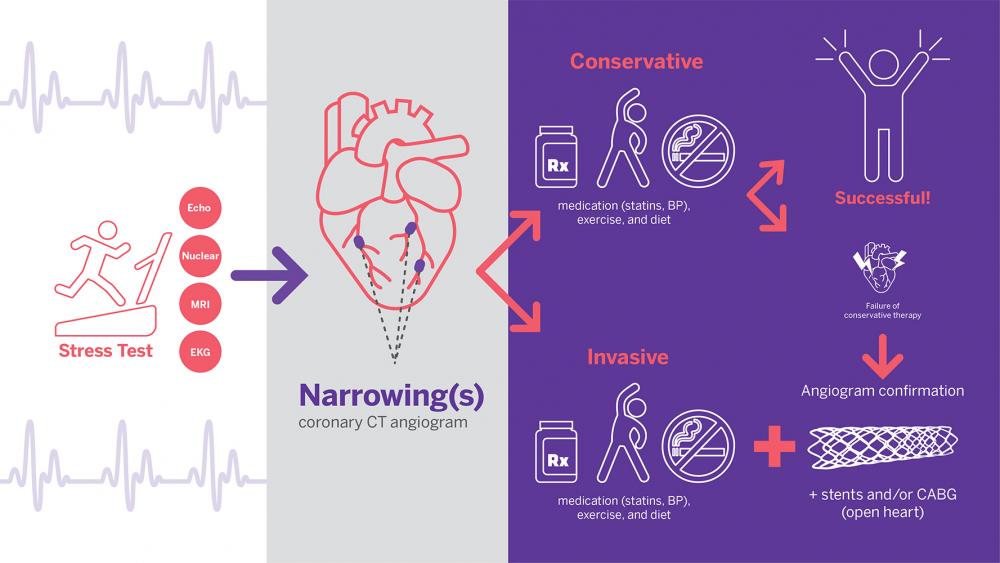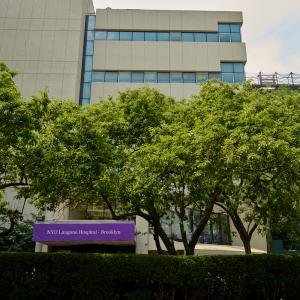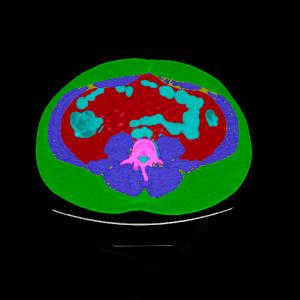
Photo: NYU Langone Staff
A federally funded, international study found no evidence that patients with severe but stable heart disease who underwent heart procedures experienced lower rates of major, disease-related events compared to those treated with medications and lifestyle changes alone.
Presented November 16 at the American Heart Association’s Scientific Sessions 2019, the study found that patients that underwent routine, invasive procedures—such as stent implants or bypass surgery—when compared with patients that received only medications such as aspirin or statins and lifestyle advice, saw no reduction in the rate of occurrence for a group of five events: cardiovascular death, heart attack, hospitalization for unstable angina, hospitalization for heart failure, or resuscitation after cardiac arrest.
Called ISCHEMIA (International Study of Comparative Health Effectiveness with Medical and Invasive Approaches), the trial also found no overall difference between the two treatment strategies in the rates of cardiovascular death or heart attack.
VIDEO: Dr. Hochman discusses the results of the ISCHEMIA trial.
At the same time, the investigators found that for patients overall with symptoms of angina—the chest pain caused by restricted blood flow to heart muscle—invasive treatments resulted in better symptom relief and quality of life that persisted for four years. Among those with daily or weekly angina at the start of the study, 50 percent of those treated invasively were angina-free after a year, compared to 20 percent of those treated with medications and lifestyle advice alone.
Both patient groups in the study received “optimal medical therapy” (OMT), the term for medications and lifestyle advice, with one group undergoing invasive procedures soon after having an abnormal stress test, and the other treated invasively only if symptoms worsened despite drug therapy, or in the case of an emergency (heart attack). The several forms of stress test used in the study, by making the heart work harder, determined the degree of blood flow restriction (ischemia) in patients’ coronary arteries.
Led by researchers at NYU Grossman School of Medicine and Stanford University, with data management and statistics led by the Duke Clinical Research Institute (DCRI), the study randomly assigned 5,179 patients at 320 sites in 37 countries to receive one of the two treatment strategies, making it more than twice as large as any previous study of its kind. The quality of life component was led by researchers at Saint Luke’s Mid America Heart Institute and DCRI.
“In line with evidence from prior studies, our results suggest that routine use of heart procedures was not superior in reducing risk for the five-part disease endpoint or death overall compared to treatment only with optimal medical therapy,” says ISCHEMIA study chair Judith Hochman, MD, the Harold Snyder Family Professor of Medicine and Senior Associate Dean for Clinical Sciences at NYU Langone Health. “On the other hand, patients symptomatic to start that got heart procedures, over the years, had fewer symptoms and felt better.”
Study Details
Funded by the National Heart, Lung, and Blood Institute, ISCHEMIA studied patients with stable ischemic heart disease (SIHD), which occurs when not enough oxygen-rich blood is supplied to heart muscle. The “vast majority” of patients in the study were determined to have moderate or severe ischemia caused by atherosclerosis, cholesterol deposits that narrow arteries. Ischemic heart disease (IHD) affects 17.6 million Americans, resulting in about 450,000 deaths annually.
For the study, “invasive” treatment meant routine catheterization, a procedure that slips a tube-like catheter into an artery in the groin or arm, and threads it through blood vessels to the heart. This was followed by revascularization when suitable—in most cases involving delivery of a balloon through the catheter to open a vessel (angioplasty), followed by the placement of a rigid stent. In other cases, improved blood flow was accomplished by cardiac bypass surgery, where another artery or a vein is used to go around (bypass) the area of blockage.
The study design reflects clinical practice, where patients with abnormal stress tests often undergo an angiogram and revascularization, with a stent implant or bypass surgery. These procedures are termed invasive because they are complex, with risks of their own that include procedure-related death, heart attack, or stroke, researchers say.
The rate of procedure-related stroke and death was “extremely” low in ISCHEMIA, but the risk of heart attacks related to procedures may explain, says Hochman, why those that had an invasive procedure had a rate of events higher by two percentage points over the first year than those that received optimal medical therapy alone (5.3 percent with invasive versus 3.4 percent for the five-part endpoint).
By year two, the event rate for the study disease endpoints was roughly the same between the two approaches (9 percent versus 9.5 percent). By four years, the rate of events was two percentage points lower in patients treated with heart procedures than in those that received medications and lifestyle advice alone (13.3 percent with invasive versus 15.5 percent). Overall, say the investigators, the trend shifts over time showed no significant evidence of a difference in rates between strategies.
Lastly, the team was surprised to see that the overall rate of heart-related events over the duration of the ISCHEMIA trial was lower than projected ten years ago. This is a testament, say the investigators, to recent advances in drug therapies and revascularization techniques.
“Based on our results, we recommend that all patients take medications proven to reduce the risk of a heart attack, be physically active, eat a healthy diet, and quit smoking,” says ISCHEMIA co-chair David Maron, MD, Director of Preventive Cardiology and the Stanford Prevention Research Center at Stanford University. “Patients without angina will not see an improvement, but those with angina of any severity will tend to have a greater, lasting improvement in quality of life if they have an invasive heart procedure. They should talk with their physicians to decide whether to undergo revascularization.”
Moving forward, the research team plans to follow the study patients for another five years, to determine whether either strategy is associated with better survival over a longer observation period.
The study was approved by the NYU Grossman School of Medicine institutional review board on March 29, 2012, with participants required to provide written consent prior to enrollment. Made possible through significant contributions by academic medical centers across the United States and globally, ISCHEMIA will be presented at the session titled LBS.02—Late breaking Science II: Results for the Ischemia Trials: To Intervene or Not to Intervene—on Saturday, November 16, 2019. The session will run from 2:00PM to 3:15PM in Main Event I at the AHA Scientific Sessions 2019, Pennsylvania Convention Center Grand Hall, Philadelphia, PA.
Media Inquiries
Rob Magyar
Phone: 212-404-3591
robert.magyar@nyulangone.org


